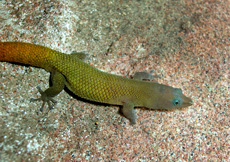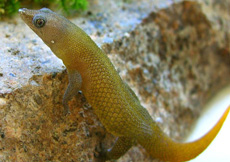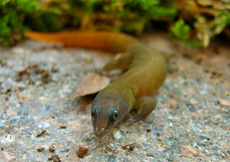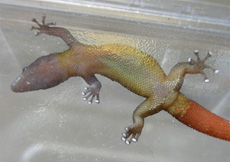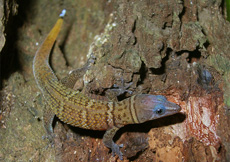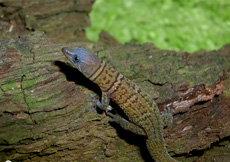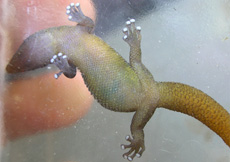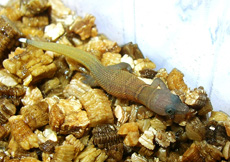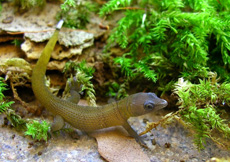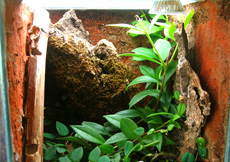Sphaerodactylus scaber
(BARBOUR & RAMSDEN, 1919)
Distribution:
Cuba: Camagüey Province, Ciego de Ávila Province, Sancti Spiritus Province
Description:
The Sphaerodactylus scaber-group which can only be found in Cuba, earned its name from Sphaerodactylus scaber. This group also includes Sphaerodactylus richardi, S. oliveri and S. storeyae. The representatives of this group have large non-overlapping scales on the back (dorsal) and three rows of small granular scales in the middle of the dorsum. Dorsally Sphaerodactylus scaber has a golden-yellow base color in both sexes, the tail is orange. Regenerated tails are more colorful than the originals and can be red. Their head is gray all the way to the neck. On the females two dark neck rings and three weak bands adorn the their body, these continue and end with a white tail tip. Ventrally Sphaerodactylus scaber is a weak yellow in both sexes, the tail is colored orange like the upper side and the lower side of the head is gray like above. Young animals look like females. At around six months, young males begin to change color. After this clearly visible in males are the shiny scales between the legs, known as Escutcheon. This provides a safe sex determination factor. The animals reach a total length of approximately 7 centimeters.
Habitat:
Sphaerodactylus scaber lives under rocks in semi-arid habitats. The animals can also be found in dead agaves and in larger groups under rubble (PAHLE, via verbal communication) where they lay their eggs.
Husbandry and Breeding:
A pair of Sphaerodactylus scaber can be kept in a terrarium with an edge length of 30 centimeters or larger. In the nature you will often find large groups of animals hanging out together in the same spot, however since animals of the same-sex quickly get into fights, you should not keep them in groups. The interior of the terrarium should mimic their natural habitat. In addition to a rear wall design of bark or fake rocks you should provide some stacked stones and pieces of bark to offer the geckos a secure location to retreat to. The substrate should be a mixture of soil and sand in a ratio of 1:1. A small permanent plant should be integrated into the terrarium design, Bromeliads are very well suited for this purpose, as the geckos like to hide in these or drink from the leaf axils. Animals in captivity must be provided at all times with a small bowl of crushed up cuttlefish bone, additionally one should be be provided for drinking water. The required daytime temperature of 26-28°C (79-82°F) can be achieved by placing two small fluorescent T5 lamps rated for daytime color over the terrarium. A small spotlight, such as a halogen puck light may also be offered help maintain the temperatures. At night when the lights are off the temperature drops to around room temperature. In summer lighting should be provided for 12 hours daily and in winter 8 hours. The humidity should be be kept around 70%, which is easily achieved by misting once daily. Feeding is carried out twice a week with suitable size arthropods. Their diet should be well varied, for this you may offer micro crickets, firebrats, tropical woodlice, springtails & aphids for example. All food should be dusted with the appropriate supplements at every feeding.
If the conditions and seasonal rhythms are met the animals will breed in the spring. About 3 weeks later the female will lay one single egg in a protected location, usually under bark or in a leaf axil of a bromeliad. If you are able to locate the egg it should be moved to an incubator for better control and be kept between 26-28°C (79-82°F) with a slightly elevated humidity. It is not yet known whether the adults will chase their young if the eggs are left in the terrarium to hatch. Following the incubation temperatures listed the young emerge between 70-90 days, with a total length of about 3.2 centimeters. To date the rearing of the young has been carried out individually or together with other species of Sphaerodactylus. The hatchlings can be housed in converted household containers, which should be supplied with a small fluorescent tube rated for daylight color to provide light and heat. The substrate is the same as for the parents. Decoration in the form of lying and upright pieces of bark, a climbing plant and a shallow water bowl should also be added. The young animals are fed with insects suitable in size along with small tropical woodlice. The animals reach sexual maturity after about 10 months and can safely be placed together at the age of for breeding at an age of one year.
Due to its size and massiveness Sphaerodactylus scaber is a very robust member of its genus. The animals however are extremely fast and are very rarely kept and bred. Due to this I would only recommend this type of Sphaerodactylus to keepers with experience.
